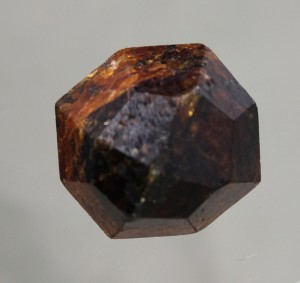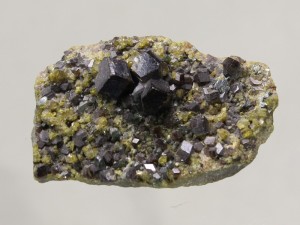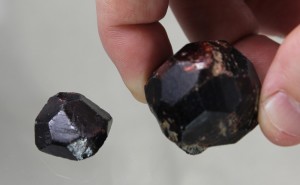Garnets with calcium in the X site are referred to as the ugrandite group. Those with aluminum in the Y site but no calcium in the X site are referred to as the pyralspite group. Garnets occur in every color imaginable and are found in most metamorphic and igneous environments. They are very hard and often are gemmy, making for wonderful gemstone rough. Their hardness combined with their natural abundance also makes them very useful in industry. Garnet is mined and crushed into a fine grit that is commonly used as an industrial abrasive. Sandpaper coated with reddish grains typically uses garnet as the abrasive. Iron containing garnet is slightly ferromagnetic and can be separated from other heavy gemstone concentrates by a powerful magnet such as a neodymium magnet.
 Out of the many varieties of garnet, the most common species as well as the most popular among mineral collectors are almandine, grossular, andradite, and spessartine though the latter is more valuable and slightly more uncommon. A very rare, bright green chromium garnet called uvarovite is also prized among mineral collectors for its vivid colors. All of these garnets occur in different geochemical environments.
Out of the many varieties of garnet, the most common species as well as the most popular among mineral collectors are almandine, grossular, andradite, and spessartine though the latter is more valuable and slightly more uncommon. A very rare, bright green chromium garnet called uvarovite is also prized among mineral collectors for its vivid colors. All of these garnets occur in different geochemical environments.
Almandine is perhaps the most common of garnets and is usually found as red, rounded to euhedral porphyroblasts in pelitic schists. Crystals usually have either 12 (dodecahedral) or 20 (trapezohedral) faces. Almandine has the composition Fe3Al2(SiO4)3. Almandine garnets can also be found as fine crystals embedded in pegmatite. Pocket almandines are somewhat rare though. The world’s largest garnet crystals are of almandine composition and grow to around a meter in width. They are found at Gore Mountain, Warren County, New York and are mined for industrial abrasive and gemstone rough.
Grossular garnet is an orange, yellow, colorless, or green garnet that has the composition Ca3Al2(SiO4)3. The name grossular is from the Latin word grossularia for gooseberry due to the berrylike appearance of the crystals. It has been known and treasured as a semiprecious stone since ancient times. Grossular occurs near strictly in metamorphic environments, particularly skarns and serpentinites- rock types that have an abundance of calcium. Colored grossulars have many varietal names. Orange to cinnamon gemmy grossular, a popular gemstone is often known as the varietal name hessonite. Tsavorite, a bright green grossular colored by trace vanadium and chromium is found only in Kenya and is among the most valuable and rarest of gemstones. Chromian grossular is very similar in color though with lighter hue and is found at many locations worldwide, particularly in serpentinites.
Spessartine is a somewhat rare mandarin orange to orange red garnet species with the formula Mn3Al2(SiO4)3. It occurs mostly in pegmatites and igneous granitic environments but also occasionally in some metamorphic manganese deposits and schists. It is moderately valuable and is known to cut fine gemstones. An extremely rare variety of spessartine from Madagascar called ‘blue garnet’ is colored blue and purple.
 Andradite is a garnet that occurs in skarns and has the composition Ca3Fe2(SiO4)3. It typically is yellow, orange, green, or black in coloration. The green version is often known as demantoid, the yellow topazolite, and the black melanite if they are found in gemmy crystals. Many other rarer kinds of garnets such as uvarovite, pyrope, kimzeyite, and goldmanite are also desirable among collectors. They are usually only found in massive portions or crude microcrystals though. Uvarovite and pyrope however have been found in larger, sometimes gemmy crystals.
Andradite is a garnet that occurs in skarns and has the composition Ca3Fe2(SiO4)3. It typically is yellow, orange, green, or black in coloration. The green version is often known as demantoid, the yellow topazolite, and the black melanite if they are found in gemmy crystals. Many other rarer kinds of garnets such as uvarovite, pyrope, kimzeyite, and goldmanite are also desirable among collectors. They are usually only found in massive portions or crude microcrystals though. Uvarovite and pyrope however have been found in larger, sometimes gemmy crystals.

